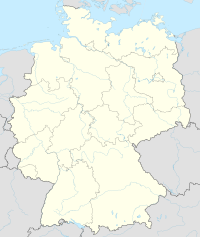German euro coins
| The euro coins |
|---|
| Eurozone |
| Associated euro users (with their own euro coins) |
| Passive euro users (without their own euro coins) |
| Possible future euro states |
| Exit clause |
The German euro coins are in Germany put into circulation Euro coins of the common European currency Euro . On January 1, 1999, Germany joined the Eurozone , which made the introduction of the Euro valid as the future payment method. The first coins were given to the public in “starter kits” on December 17, 2001, and retailers and banks were able to receive them earlier as part of what is known as “frontloading”. Like all other euro coins and notes, they became valid as a means of payment on January 1, 2002.
Circulation coins
The circulation coins have their own national motif for each of the three coin rows. The smallest row of the 1, 2 and 5 cent coins was designed by Rolf Lederbogen and features oak leaves . The middle row with the 10, 20 and 50 cent coins shows the Brandenburg Gate and was designed by Reinhart Heinsdorff . The design of the two largest coins comes from Heinz Hoyer and Sneschana Russewa-Hoyer and depicts the federal eagle . The design of the 1, 2 and 5 cent as well as the 1 and 2 euro coins is reminiscent of the motifs of the old DM coins .
In contrast to the other euro countries, German coins are produced in five different mints. These are marked on the coins by a letter near the year. The following table lists all German mints and their respective proportions in the total circulation of the German euro coins .
Mints of the German euro coins Merkhilfe: alphabetically clockwise, starting in the capital |
| character | Embossing time * | Mint | proportion of | |
|---|---|---|---|---|
| from | to | |||
| A. | 1999 | today | State Mint Berlin | 20% |
| D. | 1998 | today | Bavarian Main Mint (Munich) | 21% |
| F. | 1999 | today | State Mint Stuttgart | 24% |
| G | 1998 | today | State Mint Karlsruhe | 14% |
| J | 1998 | today | Hamburg Mint | 21% |
|
* Unlike in some other euro countries, the coins minted before 2002 bear the year of issue "2002". |
||||
There was a serious mistake in the early days of euro coin production. The stars on the first coins were not oriented upwards, as on the European flag , but rather radially. After this was noticed, the coins produced up to then were destroyed again. A few copies, however, came into circulation. These so-called rotating stars are sought after by collectors.
Like most of the euro countries, Germany has been minting its euro coins with the newly designed front since 2007 (new map of Europe).
Due to the mixing of the national euro coins, the proportion of German euro coins in Germany has slowly but steadily decreased since the introduction of the euro. According to the surveys of the Dutch website Eurodiffusie.nl , the proportion of German euro coins in the Federal Republic of Germany was just under 86% in 2006, and in 2009 it had fallen further to around 80%.
Oak leaves
The oak leaf is a symbol with history: In the German Confederation from 1815, all its members still had customs and coinage sovereignty . The German Customs Union and the Münzeinigung went hand in hand. Using the symbolic power of the oak tree as a symbol of the common Germanness for German coins goes back to the Munich Mint Treaty of 1837. This agreement made Germany a unified economic area. For the smallest of the German euro coins, the oak leaf was chosen as a familiar symbol, which also adorned the German pfennig . The motif comes from a design by Professor Rolf Lederbogen from Karlsruhe . The coin image of the 2-cent coin of the mint "G" (Karlsruhe) was reduced in size in 2016, and in 2017 the other mints followed. Since 2018, the 1 and 5 cent coins have also been minted with the reduced coin image.
Brandenburg Gate
The Brandenburg Gate , a conspicuous structure built in the classical style by Carl Gotthard Langhans and crowned with a quadriga , is a landmark of the German capital Berlin . This building reflects German history. In the German Reich it was used for parades. After the Second World War , the Brandenburg Gate became a symbol of the division of Germany . When the Berlin Wall came down in November 1989 , Germans from East and West met at the Brandenburg Gate. Since then, the opened Brandenburg Gate has stood for a united Germany and is also a symbol for the European unification process. The Brandenburg Gate has been used repeatedly as a motif on German coins since the 1930s.
In the original Quadriga, the two horses in the middle lift their inner legs, but on the design by the artist Reinhart Heinsdorff , their outer legs . The first edition with rotating stars corresponds to the design in this detail, whereas the coins actually issued are the original. The 10 and 20 cent coins according to Heinsdorff's design have only been minted since 2007.
Federal eagle
The federal eagle has been the national coat of arms of the Federal Republic of Germany since 1950. The coat of arms of the Weimar Republic from 1919 was adopted in an almost identical form . The eagle was also the coat of arms of the German Empire from 1871. The federal eagle can be found in numerous surroundings today. It hangs in the plenary hall of the German Bundestag . It can be found in German passports and ID cards as a graphic symbol and as an official stamp. The design comes from Sneschana Russewa-Hoyer and Heinz Hoyer from Berlin.
All designs contain the twelve stars of the EU, the year of issue and a letter that denotes the mint (see table).
| € 0.01 | € 0.02 | € 0.05 |
|---|---|---|
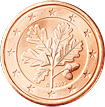
|

|
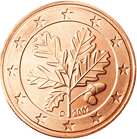
|
| Branch of a German oak , similar to the earlier Pfennig . | ||
| € 0.10 | € 0.20 | € 0.50 |
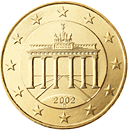
|
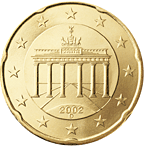
|
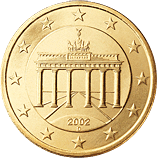
|
| The Brandenburg Gate as a symbol of division and unity. | ||
| 1.00 € | € 2.00 | Edge of the € 2 coin |
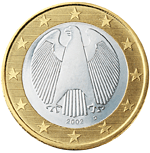
|

|
|
| The German federal eagle , symbol of German sovereignty. | " UNITY AND RIGHT AND FREEDOM |
|
Design guidelines from 2008
Most of the German euro coins do not fully comply with the design guidelines of the European Commission. These contain recommendations for the design of the national sides of the course coins. Among other things, the full or abbreviated name of the issuing country should be indicated on the national page. This is especially not observed by the German course coins. Only the mint is indicated there. Furthermore, the European stars should be arranged like on the European flag - in particular, be evenly distributed in a circle. This is not the case with the coins of the federal state series up to and including 2009. This explains the design difference between the first four and the rest of the coins in the Bundesländer series . The countries whose coins do not yet comply with the recommendations described above can make the necessary adjustments at any time; they must do this by June 20, 2062 at the latest.
2 euro commemorative coins
In 2006, Germany began to issue 2 euro commemorative coins , each dedicated to the federal state holding the Federal Council Presidency at the beginning of the year of issue . A well-known building from the respective federal state is depicted on the coins of the federal states series . The sequence of the presidencies of the Federal Council was changed from the 2017/18 financial year onwards due to the changed population figures. Schleswig-Holstein, to which the first commemorative coin was dedicated in 2006, took over the chairmanship on November 1, 2018 for 12 months - therefore the series was suspended for one year in 2019. A commemorative coin will be minted for each federal state by 2022.
| No. | image | Issue date image reference |
occasion | Official Journal reference |
Edition |
|---|---|---|---|---|---|
| 1 |  |
February 3, 2006 |
Schleswig-Holstein ( Holstentor in Lübeck ) 1st coin of the federal series |
31,500,630 | |
| 2 |  |
February 2, 2007 |
Mecklenburg-Western Pomerania ( Schwerin Castle ) 2nd coin of the federal series |
31.245.630 | |
| 3 |  |
March 25, 2007 |
50th anniversary of the signing of the Treaty of Rome, Euro-13 joint edition |
30,865,630 | |
| 4th | 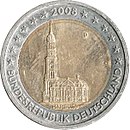 |
February 1, 2008 |
Hamburg ( St. Michaelis Church ) 3rd coin of the federal series |
30,513,630 | |
| 5 |  |
January 2, 2009 |
10th anniversary of the Economic and Monetary Union (EMU) Euro 16 joint edition |
30,565,630 | |
| 6th |  |
February 6, 2009 |
Saarland ( Ludwigskirche in Saarbrücken ) 4th coin of the federal series |
30,940,630 | |
| 7th |  |
January 29, 2010 |
Bremen ( Bremen town hall and Roland statue ) 5th coin of the federal series |
30,925,630 | |
| 8th |  |
January 28, 2011 |
North Rhine-Westphalia ( Cologne Cathedral ) 6th coin of the federal series |
30,925,000 | |
| 9 |  |
January 2, 2012 |
10th anniversary of the introduction of euro cash Euro 17 joint issue |
30,648,000 | |
| 10 |  |
3rd February 2012 |
Bavaria ( Neuschwanstein Castle ) 7th coin in the federal series |
30,883,000 | |
| 11 |  |
January 22, 2013 |
50 years of the Élysée Treaty Joint edition of Germany and France |
11,585,000 | |
| 12 |  |
1st February 2013 |
Baden-Württemberg ( Maulbronn Monastery with fountain) 8th coin of the federal series |
30,845,000 | |
| 13 |  |
February 6, 2014 |
Lower Saxony ( St. Michael in Hildesheim ) 9th coin of the federal series |
30,799,300 | |
| 14th |  |
January 30, 2015 |
Hessen ( Frankfurter Paulskirche ) 10th coin of the federal series |
30.767.100 | |
| 15th |  |
January 30, 2015 |
25 years of German unity | 30.517.100 | |
| 16 |  |
5th November 2015 |
30th anniversary of the EU flag Euro-19 joint issue |
30,125,000 | |
| 17th | 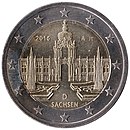 |
5th February 2016 |
Saxony ( Zwinger in Dresden ) 11th coin of the federal series |
30,677,600 | |
| 18th |  |
3rd February 2017 |
Rhineland-Palatinate ( Porta Nigra in Trier ) 12th coin of the federal series |
30,616,300 | |
| 19th |  |
January 30, 2018 |
Berlin ( Charlottenburg Palace ) 13th coin of the federal series |
30,581,900 | |
| 20th |  |
January 30, 2018 |
100th birthday of Helmut Schmidt | 20,571,900 | |
| 21st |  |
29 January 2019 |
70 years of the Bundesrat ( Prussian mansion in Berlin ) 14th coin of the federal series |
30,532,900 | |
| 22nd |  |
October 10, 2019 |
30 years since the fall of the Berlin Wall Joint edition of Germany and France |
30,339,400 | |
| 23 |  |
January 28, 2020 |
Brandenburg ( Sanssouci Palace, Potsdam ) 15th coin of the federal series |
30,000,000 | |
| 24 | October 8, 2020 |
50 years of Warsaw kneeling down | |||
| 25th | January 26, 2021 |
Saxony-Anhalt ( Magdeburg Cathedral ) 16th coin of the federal series |
|||
| 26th | 2022 |
Thuringia ( Wartburg ) 17th coin of the federal series |
|||
| 27 | 2022 | 35 years of the Erasmus program Euro 19 joint edition |
Collector coins
Since 2002, 10 euro commemorative silver coins have also been minted annually in the various mints . These remind of certain people, events or sights. A special feature are the commemorative coins on the occasion of various sporting events (e.g. soccer World Cup 2006 ). These coins were produced in equal proportions in all five German mints. They do not have an embossed letter, but can only be assigned to their mint through minimal differences. From 2011, the weight and the precious metal content were reduced due to the increased silver price , and the coins (with the exception of the first 2011 coin) are also minted in a copper-nickel alloy. As of 2016, the 10 euro commemorative coins were replaced by those with a face value of 20 euros.
In addition, a 100 euro gold coin is issued each year. In 2002, the introduction of the euro was honored with the 10 euro coin made of 925 silver and the 100 euro gold coin with a 200 euro gold coin. At the beginning of 2010, the Federal Ministry of Finance in Berlin announced that from June 2010 another annual gold coin with a face value of EUR 20 will be released for a period of 6 years. While the 100-euro gold coins are made from half an ounce of fine gold (the 200-euro coin from one ounce in 2002), the 20-euro coins are made from 1/8 ounce of fine gold. The 100 euro coins currently honor the Unesco world cultural sites in Germany. The 20 euro coins are dedicated to the topic of the “German forest”. From 2016 the series “German Forest” was continued with “Domestic Birds”. In addition, in 2017, on the occasion of the 500th anniversary of the Reformation, a gold coin with a face value of 50 euros was issued for the first time; from 2018 a series with the same face value will follow under the title "Musical Instruments".
A 5 euro commemorative coin has been issued annually since 2016. The coins are made up of three components: an outer ring, the inner core and an intermediate colored polymer ring that is partially translucent. A copper-nickel alloy is used as the metal. The weight is 9.0 grams and the diameter is 27.25 mm.
See also
Web links
Individual evidence
- ↑ Glossary eurostat Retrieved October 20, 2015.
- ↑ Texts on the euro: The euro coins - from conception to issue, May 2000, p. 13 (PDF 3.9 kB)
- ↑ 2-cent coin 2016 with a reduced image , accessed on February 9, 2018.
- ↑ Gerhard Schön: Euro coin catalog . 9th edition. Battenberg, 2010, ISBN 978-3-86646-053-9 .
- ↑ Quadriga representation on German cent coins.Retrieved on November 24, 2013.
- ↑ Recommendation of the European Commission of December 19, 2008 on common guidelines for the national pages and the issue of euro coins intended for circulation (PDF; 37 kB)
- ↑ EU Regulation No. 566/2012, Article 1g, from June 18, 2012 (PDF) Retrieved on February 28, 2012.
- ↑ Deutsche Bundesbank: German 2 euro circulation coins with commemorative character ( Memento of February 8, 2013 in the Internet Archive )
- ↑ Presidencies of the Federal Council from the 2017/2018 financial year , accessed on November 11, 2016.
- ↑ Münzscan 2 Euro commemorative coin 2006 Germany: Schleswig-Holstein , accessed on February 9, 2018
- ↑ Official Journal of the European Union: New national side of the euro coins in circulation (2006 / C 33/04, February 9, 2006) , accessed on July 19, 2015
- ↑ Germany 2006: Schleswig-Holstein , accessed on July 9, 2013
- ↑ Münzscan 2 euro commemorative coin Germany 2007 Mecklenburg-Vorpommern , accessed on February 9, 2018
- ↑ Official Journal of the European Union: New national side of the euro coins in circulation (2007 / C 76/02, April 4, 2007) , accessed on July 9, 2013
- ↑ Germany 2007: Mecklenburg-Western Pomerania , accessed on November 12, 2019
- ↑ Münzscan Germany 2007: Treaties of Rome , accessed on November 12, 2019
- ↑ Official Journal of the European Union: New national pages for euro coins in circulation (2007 / C 65/04, March 21, 2007) , accessed on July 19, 2015
- ^ Joint edition 2007 - Treaties of Rome , accessed on July 9, 2013
- ↑ Münzscan 2 euro commemorative coin Germany 2008 Hamburg , accessed on February 13, 2014
- ↑ Official Journal of the European Union: New national side of the euro coins in circulation (2008 / C 13/02, January 18, 2008) , accessed on July 9, 2013
- ↑ Germany 2008: Hamburg , accessed on July 9, 2013
- ↑ Münzscan Germany 2009: Monetary Union , accessed on November 12, 2019
- ↑ Official Journal of the European Union: New national side of the euro coins in circulation (2008 / C 315/04, December 10, 2008) , accessed on July 9, 2013
- ↑ Joint edition 2009: Economic and Monetary Union , accessed on July 9, 2013
- ↑ Münzscan 2 euro commemorative coin Germany 2009 Saarland , accessed on February 13, 2014
- ↑ Official Journal of the European Union: New national side of the euro coins in circulation (2009 / C 31/06, February 7, 2009) , accessed on July 9, 2013
- ↑ Germany 2009: Saarland , accessed on July 9, 2013
- ↑ Münzscan 2 euro commemorative coin Germany 2010 Bremen , accessed on February 9, 2018
- ↑ Official Journal of the European Union: New national side of the euro coins in circulation (2010 / C 12/05, January 19, 2010) , accessed on July 9, 2013
- ↑ Germany 2010: Gedenkmünze Bremen , accessed on January 20, 2014
- ↑ Münzscan 2-euro commemorative Germany 2011 North Rhine-Westphalia , accessed on February 13, 2014
- ↑ Official Journal of the European Union: New national side of the euro coins in circulation (2011 / C 24/04, January 26, 2011) , accessed on July 9, 2013
- ↑ Germany 2011: North Rhine-Westphalia , accessed on July 11, 2013
- ↑ Münzscan Germany 2012: Euro cash , accessed on November 12, 2019
- ↑ Official Journal of the European Union: New national pages for euro coins in circulation (2012 / C 17/05, January 20, 2012) , accessed on July 9, 2013
- ↑ Joint issue 10 Years of Euro Cash , accessed on January 20, 2014
- ↑ Münzscan 2 euro commemorative coin Germany 2012 Bavaria , accessed on February 13, 2014
- ↑ Official Journal of the European Union: New national side of the euro coins in circulation (2012 / C 10/02, January 12, 2012) , accessed on July 20, 2015
- ↑ Germany 2012: Gedenkmünze Bayern , accessed on January 20, 2014
- ↑ Münzscan Germany 2013: Élysée contract , accessed on November 12, 2019
- ↑ Official Journal of the European Union: New national side of the euro coins in circulation (2013 / C 21/04, January 24, 2013) , accessed on January 20, 2014
- ↑ Germany 2013: Commemorative coin 50 years of the Élysée Treaty , accessed on January 20, 2014
- ↑ Münzscan 2 euro commemorative coin Germany 2013 Baden-Württemberg , accessed on February 9, 2018
- ↑ Official Journal of the European Union: New national side of the euro coins in circulation (2013 / C 379/08, December 28, 2013) , accessed on January 20, 2014
- ↑ Germany 2013: Commemorative coin Baden-Württemberg: Maulbronn Monastery , accessed on January 20, 2014
- ↑ Münzscan 2 Euro commemorative coin Germany 2014 Lower Saxony , accessed on February 9, 2018
- ↑ Official Journal of the European Union: New national side of the euro coins in circulation (2014 / C 417/04, November 21, 2014) , accessed on November 21, 2014
- ↑ Germany 2014: Commemorative coin Lower Saxony: St. Michael (Hildesheim) , accessed on November 26, 2014
- ↑ Münzscan Germany 2015: Hesse (Paul's Church) , accessed on 19 March 2015
- ↑ Official Journal of the European Union: New national side of the euro coins in circulation (2015 / C 143/05, April 30, 2015) , accessed on December 14, 2018
- ^ Commemorative coin Germany 2015: Hessen , accessed on December 14, 2018
- ↑ Münzscan Germany 2015: German unit , accessed on 19 March 2015
- ↑ Official Journal of the European Union: New national side of the euro coins in circulation (2014 / C 417/05, November 21, 2014) , accessed on January 30, 2015
- ↑ Commemorative coin Germany 2015: 25 Years of German Unity , accessed on January 30, 2015
- ↑ Münzscan Germany 2015: EU flag , accessed on November 12, 2019
- ↑ Official Journal of the European Union: New national side of the euro coins in circulation (2015 / C 253/08, August 1, 2015) , accessed on August 6, 2015
- ↑ Commemorative coin Germany 2015: 30 years of the European flag , accessed on August 6, 2015
- ↑ Münzscan Deutschland 2016: Saxony , accessed on May 12, 2017
- ↑ Official Journal of the European Union: New national side of the euro coins in circulation (2015 / C 428/04, December 19, 2015) , accessed on February 3, 2016
- ^ Commemorative coin Germany 2016: Saxony , accessed on February 3, 2016
- ↑ Münzscan Germany 2017: Rhineland-Palatinate , accessed on May 12, 2017
- ↑ Official Journal of the European Union: New national side of the euro coins in circulation (2017 / C 23/04, January 24, 2017) , accessed on February 3, 2017
- ↑ Commemorative coin Germany 2017: Rhineland-Palatinate , accessed on December 14, 2018
- ↑ Münzscan Deutschland 2018: Berlin , accessed on January 31, 2018
- ↑ Official Journal of the European Union: New national side of the euro coins in circulation (2018 / C 400/05, 6 November 2018) , accessed on 8 November 2018
- ↑ Commemorative coin Germany 2018: Berlin , accessed on January 30, 2018
- ↑ Münzscan Deutschland 2018: Helmut Schmidt , accessed on January 31, 2018
- ↑ Official Journal of the European Union: New national side of the euro coins in circulation (2017 / C 444/05, 23 December 2017) , accessed on 30 January 2018
- ↑ Commemorative coin Germany 2018: 100th birthday of Helmut Schmidt , accessed on January 30, 2018
- ↑ Münzscan Deutschland 2019: Bundesrat , accessed on August 13, 2019
- ↑ Official Journal of the European Union: New national side of the euro coins in circulation (2018 / C 466/08, December 28, 2018) , accessed on February 2, 2019
- ↑ Commemorative coin Germany 2019: 70 years of the Federal Council , accessed on February 2, 2019
- ↑ Münzscan Germany 2019: Fall of the Wall , accessed on December 20, 2019
- ↑ Official Journal of the European Union: New national side of the euro coins in circulation (2019 / C 351/08, October 17, 2019) , accessed on October 23, 2019
- ↑ Commemorative coin Germany 2019: 30 years since the fall of the Berlin Wall , accessed on October 10, 2019
- ^ Coin image Germany 2020: Brandenburg , accessed on February 27, 2020
- ↑ Official Journal of the European Union: New national side of the euro coins in circulation (2020 / C 49/11) , accessed on February 13, 2020
- ↑ Commemorative coin Germany 2020: Brandenburg , accessed on January 29, 2020
- ^ Coin image Germany 2020: Kniefall von Warsaw , accessed on November 6, 2019
- ^ Coin image Germany 2021: Saxony-Anhalt , accessed on April 3, 2019
- ^ Coin image Germany 2022: Thuringia , accessed on April 3, 2019
- ↑ Collector Coins. Retrieved July 2, 2017 .
- ↑ World novelty: 5 euro collector's coin “Planet Earth” with a blue ring. Retrieved July 2, 2017 .
- ↑ 5 euro coins - overview and value. Retrieved April 3, 2017 .
